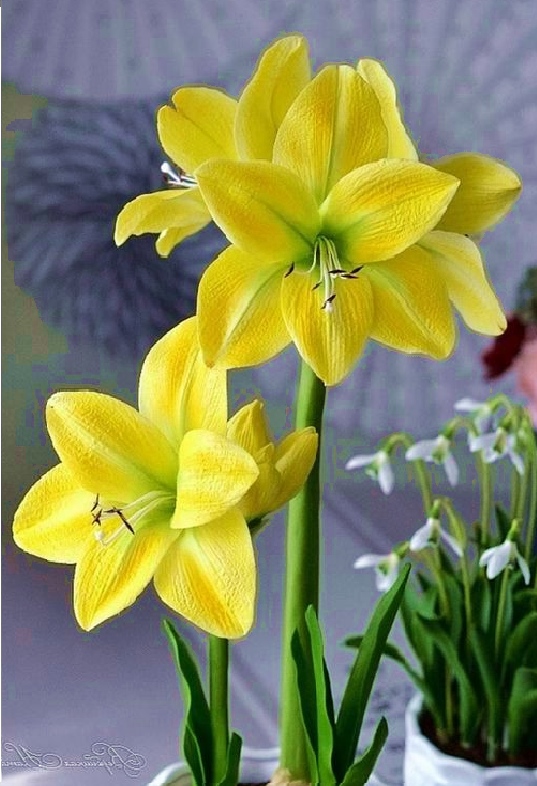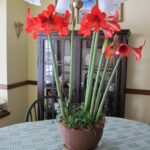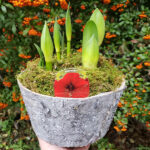Amaryllis, with its stunning, trumpet-shaped blooms and vibrant colors, is a favorite among both novice and experienced gardeners. Native to South America, this flowering plant is particularly popular during the winter holidays for its ability to bloom indoors. Whether you’re looking to brighten up your home or garden, growing amaryllis can be a rewarding and relatively simple endeavor. Here’s a step-by-step guide to help you grow these beautiful flowers successfully.
Choosing the Right Bulb
- Quality Matters: Start with a healthy, large bulb. Larger bulbs generally produce more flowers. Look for firm, blemish-free bulbs without mold or soft spots.
- Variety Selection: Amaryllis comes in many varieties, including single and double blooms, as well as a range of colors from classic red and white to exotic pinks and oranges. Choose a variety that appeals to your aesthetic preferences.
Planting Amaryllis
- Timing: The best time to plant amaryllis bulbs is from October to April, depending on when you want them to bloom. For holiday blooms, plant in October or early November.
- Container Choice: Use a pot with drainage holes to prevent waterlogging. The pot should be about 6-8 inches in diameter to provide enough space for root growth.
- Soil Preparation: Amaryllis thrives in well-draining soil. A mix of potting soil and sand or perlite works well. Ensure the soil is slightly acidic to neutral (pH 6.0-7.0).
Planting Steps
- Prepare the Bulb: Soak the base of the bulb in lukewarm water for a few hours before planting to jump-start root growth.
- Planting Depth: Plant the bulb so that about one-third to half of the bulb is above the soil surface. This helps prevent rot and allows the bulb to breathe.
- Positioning: Place the pot in a bright, warm location. Amaryllis needs plenty of indirect sunlight. A temperature of 70-75°F (21-24°C) is ideal for growth.
Watering and Feeding
- Watering: Water sparingly until you see new growth. Once the stem and leaves appear, keep the soil consistently moist but not waterlogged. Reduce watering after flowering to allow the bulb to go dormant.
- Fertilizing: Use a balanced liquid fertilizer every 2-4 weeks during the growing season. Stop fertilizing once the plant stops blooming.
Encouraging Blooming
- Light: Ensure the plant gets at least 6 hours of indirect sunlight daily. Rotate the pot regularly to keep the stem straight.
- Support: Tall varieties might need staking to support the heavy blooms.
- Temperature: Keep the plant in a warm room. Avoid placing it near drafts or heat sources.
Post-Bloom Care
- Deadheading: Remove spent flowers to prevent the plant from using energy to produce seeds.
- Foliage Maintenance: Continue watering and feeding until the leaves naturally yellow and die back. This process helps the bulb store energy for the next blooming cycle.
- Dormancy: Allow the bulb to go dormant for at least 8-10 weeks. Place the pot in a cool (50-55°F/10-13°C), dark place during dormancy. Water sparingly.

Reblooming Amaryllis
- Repotting: After the dormancy period, repot the bulb in fresh soil if needed.
- Restart Growth: Move the pot back to a warm, bright location and resume watering. New growth should start in a few weeks.
Common Problems and Solutions
- Bulb Rot: Ensure proper drainage and avoid overwatering. Plant the bulb with part of it above the soil line.
- Pests: Watch for aphids, mealybugs, and spider mites. Treat infestations with insecticidal soap or neem oil.
- Lack of Blooms: Insufficient light, nutrients, or incorrect dormancy can result in poor blooming. Ensure proper care throughout the growing cycle.
Conclusion
Growing amaryllis can be a delightful and satisfying experience, providing stunning blooms that brighten up any space. By following these guidelines on bulb selection, planting, and care, you can enjoy the beauty of amaryllis year after year. Whether you’re a seasoned gardener or a beginner, the amaryllis is a resilient and rewarding plant that brings joy and color to your home.
 Flower Love
Flower Love





























